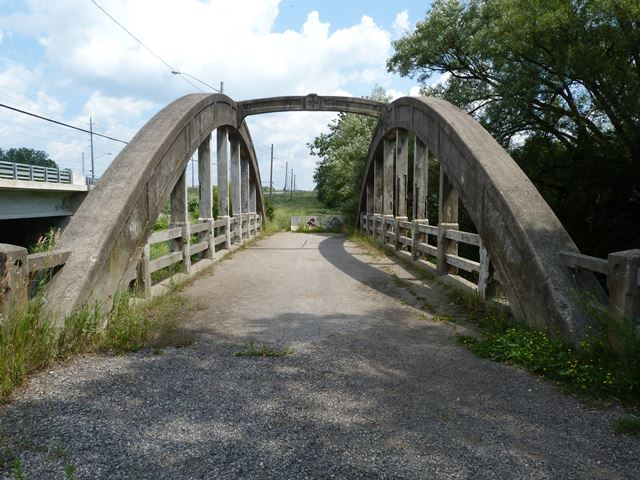We Recommend:
Bach Steel - Experts at historic truss bridge restoration.
Stone Road Bridge
McQuillian's Bridge

Primary Photographer(s): Nathan Holth and Rick McOmber
Bridge Documented: July 19, 2013
Guelph: Wellington County, Ontario: Canada
1916 By Builder/Contractor: Charles Borromeo Mattaini of Fergus, Ontario
Not Available or Not Applicable
Not Available
69.9 Feet (21.3 Meters)
Not Available
1 Main Span(s)
Not Applicable

View Information About HSR Ratings
Bridge Documentation
This bridge is a beautiful example of a rainbow arch bridge, also called a concrete bowstring arch bridge. It is one of a once-large, but today shrinking number of such bridges surviving in Wellington County. This is one of the few that does not appear to be at risk for demolition. In 2000, the bridge was bypassed with a modern replacement bridge on new alignment nearby. This heritage bridge was allowed to remain standing where it carries pedestrian traffic as part of a trail system. The bridge was built by a noted contractor, Charles Mattaini, under the guidance of Wellington County engineer A. W. Connor. Constructed in 1916, this is an early surviving example of this attractive and noteworthy structure type. This bridge is listed on the Ontario Heritage Bridge List.
![]()
Photo Galleries and Videos: Stone Road Bridge
Bridge Photo-Documentation
Original / Full Size PhotosA collection of overview and detail photos. This gallery offers photos in the highest available resolution and file size in a touch-friendly popup viewer.
Alternatively, Browse Without Using Viewer
![]()
Bridge Photo-Documentation
Mobile Optimized PhotosA collection of overview and detail photos. This gallery features data-friendly, fast-loading photos in a touch-friendly popup viewer.
Alternatively, Browse Without Using Viewer
![]()
Maps and Links: Stone Road Bridge
Coordinates (Latitude, Longitude):
Search For Additional Bridge Listings:
Additional Maps:
Google Streetview (If Available)
GeoHack (Additional Links and Coordinates)
Apple Maps (Via DuckDuckGo Search)
Apple Maps (Apple devices only)
Android: Open Location In Your Map or GPS App
Flickr Gallery (Find Nearby Photos)
Wikimedia Commons (Find Nearby Photos)
Directions Via Sygic For Android
Directions Via Sygic For iOS and Android Dolphin Browser

